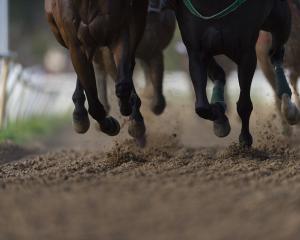A harness racing programme full of hot favourites could soon be a thing of the past.
That is if one of the key aims of harness racing's new handicapping system is effective, after it is implemented next month.
A group of 20 Otago harness racing participants attended a presentation from Harness Racing New Zealand outlining the system at Forbury Park yesterday.
Harness Racing New Zealand chief executive Edward Rennell, national handicapper Andrew Morris, North Island handicapper Kevin Smith and handicapping subcommittee chairman and board member Rob Lawson all spoke at the meeting.
Southern Harness general manager Jason Broad, who plays a key role in the compilation of Otago harness racing fields, also spoke about the impacts of the new system.
By March 13, when the new system is introduced, all harness horses will be handicapped by a rating, rather than the wins assessment method that is currently used.
When horses win, place or run poorly in races, their ratings will be adjusted with discretion by handicappers relative to the strength and stake money of that race.
The basis of the new rating system, which has an extensive list of guiding principles, is to place horses of similar ability and form in the same races.
Meeting attendees were given a raft of possible benefits the system could produce.
Two of the key aims included increasing both betting turnover and the longevity of a horse's career.
More even fields with fewer short-priced favourites would attract more betting turnover, Morris told the meeting.
''We want to see more even and more balanced racing and less short-priced favourites.''
Harness Racing New Zealand is so committed to producing even fields it is in the early stages of developing a measuring system for horse competitiveness with the TAB.
The system will gauge the amount of money bet on individual races in relation to the competitive make-up of that field.
Harness Racing New Zealand enforced the importance of the punter and betting confidence to the industry, the meeting was told.
Educating the betting public about the new system so they can measure the performance of horses and be encouraged to have a bet was an important part of its roll-out.
''Our money comes from the punter, essentially,'' Morris said.
''They have to have a good comprehension of how the system works.''
A changing racing population meant a new handicapping system was inevitable.
''Some change has to happen, somehow, some way.''
The system is the fourth of its kind to be used in New Zealand since 1994.
The new ratings system began as a proposal from the New Zealand Trainers and Drivers Association and other concerned industry groups in April 2016.
Once the system was developed, it was trialled in the North Island from August 2016.
Though there were no official figures in the meeting's presentation document, attendees were told the North Island trial did have positive effects on betting turnover and horse numbers.
That positive response led to a national roll-out of the system being approved in November last year.
Meeting attendees were given the opportunity to ask the panel questions about the new system.
Several people took up that opportunity and asked a number of technical questions about a range of scenarios of where a horse could be placed to race.
-By Jonny Turner














